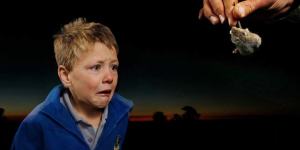Perhaps the five-year-old has heard that mice,contrary to their sweet,storybook reputation,are savage beasts that eat their young and destroy crops newly sown by farmers like his father.

Mice invasion ... Environmental conditions have seen numbers of mice increase in significant numbers across four states including NSW.Andrew Meares
Murray Thomas,40,is more sanguine than his son. Mr Thomas,who caught a mouse at the behest of theHerald,knew he had to dispose of it. So once a picture was taken,he counted to four,dropped the mouse to the ground,stamped on it,picked up the corpse and flung it into the night.
''The flying mice of Forbes,''he chuckled,then cuddled his son and asked for his beer.
The Thomas family farm,off the Lachlan Valley Way between Forbes and Cowra,is one of hundreds of properties affected by the mouse plague,which is the result of the country's luckless summer.
The large amounts of rain that fell during the summer months produced a bumper crop and,in some cases,made harvesting difficult,meaning there is plenty of grain-food and ground-cover:party conditions for mice.
A shortage of rodenticides and the fast breeding cycle of mice - a new generation is produced every six weeks - have compounded the problem.
The NSW Department of Primary Industries has warned farmers to be vigilant,reporting that''significant damage''has been done to winter crops in the worst-affected areas in western NSW,which include Wentworth,Deniliquin,Condobolin,Forbes,Lockhart and Griffith. Medium levels of mouse activity are reported in the central west,central north and Hume areas.
Mr Thomas knew he had a problem a few weeks ago when he and his wife,Emma,began seeing''more activity''around the house:mice springing out from curtains,scuttling around the kitchen and,once,running across a pillow.
Outdoors,more baits than usual were being eaten and it soon became clear hordes of mice were feasting on the unharvested seed from the Thomases'summer crop of canola and his newly sown wheat.
He began''perimeter-baiting''- scattering grain laced with the mouse poison bromadiolone around the edges of his paddocks.
The Lachlan Livestock Health and Pest Authority mixed about 3700 kilograms of this bait in April and another 3200 kilograms so far this month.''We may not have seen the worst of it yet,''Mr Thomas says of this year's plague.
Until now the rodents have been living in the paddocks but,with the cold weather coming,they are moving towards the homestead,which does not amuse Mr Thomas's English-born wife,who doesn't''do''mice,on account of her Buddhist beliefs.
Exact numbers of mice are difficult to know. One estimate puts them at 8000 per hectare but,according to Craig Ridley,senior ranger at the Lachlan LHPA,any estimate is''a bit of a stab in the dark sort of a job''.
The deputy mayor of Forbes,Graham Falconer,who works as an agronomist,hopes the elements will conspire to end the plague.''If we get wet cold weather they might die off. Pneumonia is a big problem for mice.''
Crop damage is not the only threat the mice pose. Six cases of leptospirosis,caused by bacteria found in mouse urine,have been reported to the Greater Southern Area Health Service.
Mice have also been linked to a near-fatal fire in a house near Blighty in the southern Riverina. It is believed they chewed through electrical wires.